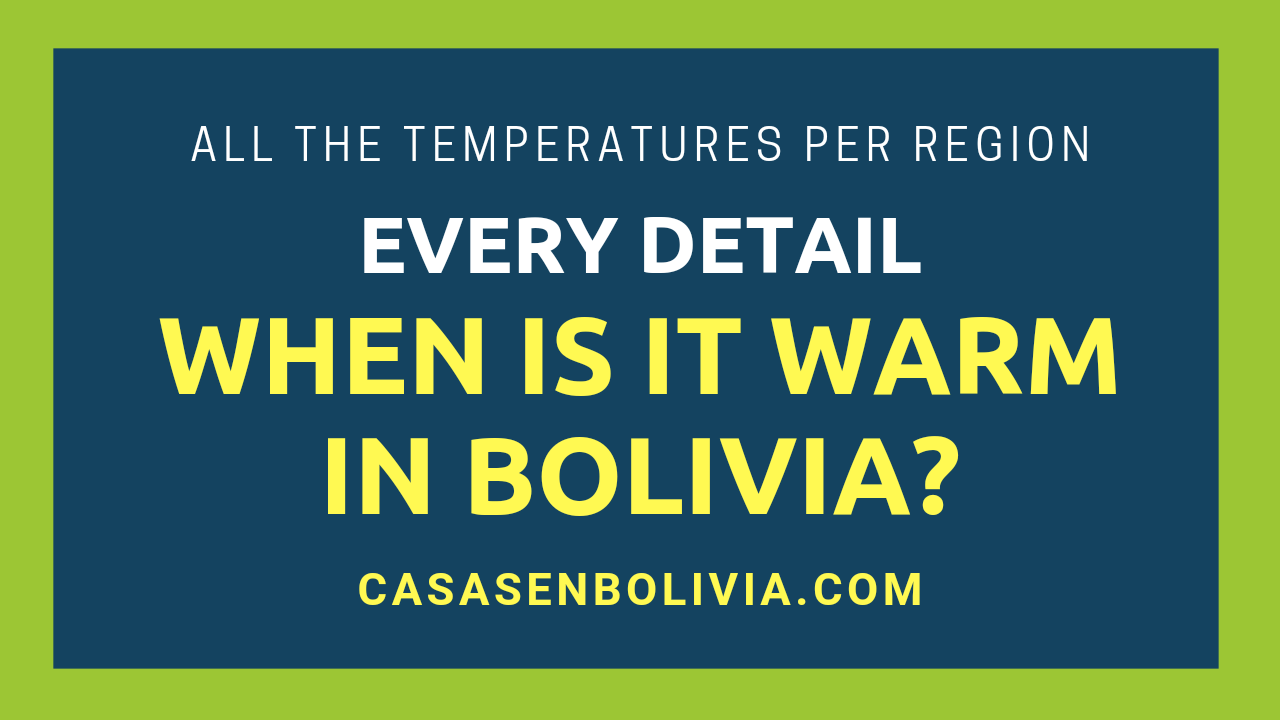Last Updated on February 15, 2025
Bolivia isn’t known for extreme heat like some other countries, but it certainly has a warm season each year. This period spans from the end of one year to the beginning of the next, encompassing parts of spring and summer. During this time, temperatures rarely drop below 60°F (16°C) or exceed 100°F (38°C).
Bolivia is warmest between August and March, but the hottest months are from November to January. Temperatures can rise by 10°F to 20°F above average during these months in any part of the country, reaching around 65°F (18°C) in Altiplanic areas, 75°F (24°C) in temperate regions, and 95°F (35°C) in tropical regions.
Here, we’ll provide all the details and figures about the warmest time of year in Bolivia. You’ll also learn about when temperatures rise, how long they remain elevated, and when they fall, for different regions and climates within Bolivia. We are Bolivian citizens who have lived here our entire lives.
The Time of Year When Bolivia is Warm
Bolivia’s warm season occurs during parts of both spring and summer, specifically from October to February each year. In fact, the hottest months are November, December, and January, across all the country’s principal regions.
In Bolivia, spring runs from September 21st to December 20th, and summer runs from December 21st to March 20th. Therefore, as you can see, *from the latter half of spring to the first half of summer*, you’ll experience the warmest period in the country.
Typically, temperatures begin to rise as early as August, but this increase is not very pronounced, and you’ll start to feel it around October. After January, temperatures begin to decrease, and many rainy days occur, primarily in February and March. However, you won’t experience truly cold temperatures until May.
The Warm Period in Bolivia’s Three Main Climates
The temperature changes described above are a climatic phenomenon *present across all regions of Bolivia*. You’ll experience these same warm periods, at the same time of year, regardless of whether you’re in a tropical or an Altiplanic region.
However, different regions of Bolivia will experience different temperature levels due to their varying geographies and altitudes. Consequently, some regions will still be cold during warm periods, while others may even reach heatwave conditions in some cases.
1) The Altiplanic West
This region of Bolivia is located on the western side of the country, at a very high altitude, exceeding 13,000 ft (3,962 m) above sea level. La Paz, Oruro, Potosí, and El Alto are situated in this part of the country. These cities typically have average temperatures of 60°F (16°C), but between October and March, temperatures can increase by 10°F to 20°F (5°C to 11°C).
The average temperature in Bolivia’s Altiplanic West is 60°F (16°C) during the day and 45°F (7°C) at night, *but from October to March, the average can increase* to 70°F (21°C) and 60°F (16°C), respectively.
On some days, primarily between November and January (the warmest months in the country), temperatures can even reach 80°F (27°C) during the day but remain at 60°F (16°C) at night in this part of the country.
Also, during this time, there will be a mix of cloudy and sunny days. *Most sunny days occur from October to December*, and you’ll experience more humidity and rainy days from January to March, with temperatures remaining warm.
2) The Hilly, Temperate Center
Surrounding the Andes Mountains is Bolivia’s hilly central corridor, where Cochabamba, Sucre, and Tarija are located. This region also has a moderate altitude (approximately 7,000 ft or 2,134 m above sea level). Cities located here typically have an average temperature of 70°F (21°C), but during the warmest period, it can increase by 10°F to 15°F (5°C to 8°C).
The average temperature in Bolivia’s hilly, rugged, and typically mild center is 70°F (21°C) during the day and 60°F (16°C) at night, *but from October to March, the average can increase* to 80°F (27°C) and 70°F (21°C), respectively.
Also in this region, between November and January (the country’s warmest months), you’ll experience the warmest days of the year, with some reaching around 85°F (29°C) during the day and 70°F (21°C) at night.
As in other regions of Bolivia, at the end of the year, between October and December, many sunny days with warm temperatures will occur. However, from January to March, you’ll experience many rainy and humid days, with temperatures remaining warm in this region.
3) The Tropical East
Bolivia is predominantly a tropical country. This region is in the east, and parts of it even belong to the Amazon. Therefore, as you can imagine, temperatures are very hot throughout the year. Santa Cruz, Trinidad, and Cobija are located in this region, which has an average altitude of 2,200 ft (671 m) above sea level.
These cities typically have an average temperature of 85°F (29°C), but between October and March, it can increase by 10°F to 15°F (5°C to 8°C).
The average temperature in Bolivia’s tropical East is 85°F (29°C) during the day and 75°F (24°C) at night, *but from October to March, the average can increase* to 95°F (35°C) and 80°F (27°C), respectively.
Furthermore, on some days, mostly from November to January (the country’s hottest months), this region can reach temperatures of 105°F (41°C) during the day and 85°F (29°C) at night.
As you can see, the risk of heatstroke is a real possibility in this region and its cities, *so take appropriate precautions to avoid it, particularly from November to January*.
As in other regions, most sunny days occur from October to December, and most rainy days occur from January to March. You’ll experience a *very humid climate* during this time. *Whenever it rains in Bolivia’s tropical East, the risk of dengue fever emerges*. Be cautious about this health threat as well.
| August to October | November to January | February to March | |
| Temperature Change | Starts to rise | Warmest period | Starts to fall |
| Temperature Change (°F) | Up 10°F to 20°F | Stable (some days with +5°F to +10°F) | Down 10°F to 20°F |
| Altiplanic West (La Paz, Oruro, Potosí, El Alto) | Day: 60°F, Night: 45°F | Day: 70°F, Night: 60°F (Peaks; Day: 80°F, Night: 60°F) | Day: 60°F, Night: 45°F |
| Mountainous Center (Cochabamba, Sucre, Tarija) | Day: 70°F, Night: 60°F | Day: 80°F, Night: 70°F (Peaks; Day: 85°F, Night: 70°F) | Day: 70°F, Night: 60°F |
| Tropical East (Santa Cruz, Trinidad, Cobija) | Day: 85°F, Night: 75°F | Day: 95°F, Night: 80°F (Peaks; Day: 105°F, Night: 85°F) | Day: 85°F, Night: 75°F |
Even During Warm Periods, You May Feel Very Cold
If you’re staying in the western part of the country, in cities like La Paz, Oruro, Potosí, or El Alto, or in places like Uyuni’s Salt Flats located in this region, *even during the warmest time of the year, you’ll still feel cold on some days*.
During many days between October and March, and on some days between November and January in this region, you’ll experience temperatures around the 70s°F (21°C) and even 60s°F (16°C) at night. Therefore, you’ll still need to use warm clothing, especially if you’re accustomed to living in a tropical location.
In fact, in cities like La Paz and Oruro, even during this time of year, people still wear multiple layers of clothing. They simply aren’t used to wearing T-shirts, shirts, or dresses during this period. Many people will continue to wear clothing suitable for cold climates and feel cold during these months. *However, this depends heavily on your personal preferences and where you come from*.
What is the Hottest Time in Bolivia?
As we mentioned in the previous sections, you’ll experience the hottest time of the year *between November and January* each year, regardless of the region you’re in.
However, each of Bolivia’s climates – the Altiplanic West, the central corridor, and the tropical East – will have unique characteristics during this time. For example, in the Altiplanic West, you might even encounter mosquitoes and rainstorms, while in the tropical East, you’ll be at risk of dengue fever, tropical storms, heatstroke, and other situations.
We have another article where we discuss these threats and scenarios, as well as the details and facts of the hottest time in the country.
We have a comprehensive overview of the hottest time in Bolivia, with all the details about temperatures, risks, unique elements, and the hottest days and months by area and climate: The hottest time in Bolivia: all you need to know.
Conclusions:
In this article about how cold Bolivia is in winter, you’ve learned that Bolivia indeed becomes colder during this season, which runs from June 21st to August 20th. However, the degree of cold varies significantly depending on the climate region.
For instance, you’ve seen that in Bolivia’s Altiplanic West, nighttime temperatures typically hover near freezing, averaging 40°F (4°C), while daytime temperatures are cold, averaging 60°F (16°C). In Bolivia’s central region, which normally has a mild climate, winter brings temperatures down to 50°F (10°C) at night and 70°F (21°C) during the day. Finally, in Bolivia’s tropical East, temperatures remain almost constant, with 60°F (16°C) at night and 80°F (27°C) during the day.
You’ve also learned that Surazos, strong winds from the South Pole, cause colder temperatures in Santa Cruz during winter. Additionally, La Paz is slightly warmer than Oruro, Potosí, and El Alto. Furthermore, many nights in these Altiplanic cities drop to freezing temperatures, around 10°F (-12°C). Finally, the coldest period in Bolivia is in late June and early July, both months falling within winter.
We hope this information has been helpful. If you’d like to learn every detail about the climate in Bolivia, including how cold the country gets in other seasons like autumn and spring, please visit our definitive guide here: How is the climate in Bolivia? A complete overview.
CasasenBolivia.com, information on living, working, investing, and traveling in Bolivia.








